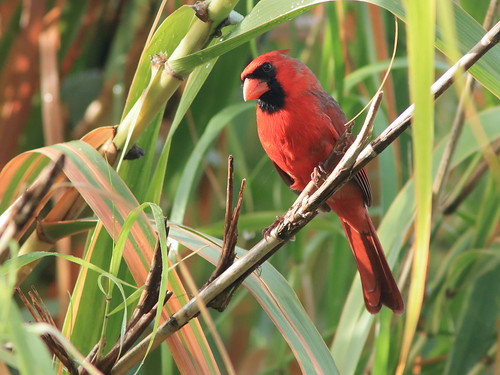
A White-eyed Vireo was feeding on Lantana berries and approached so closely to my secluded "sit-spot" that I could barely fit it into my viewfinder:
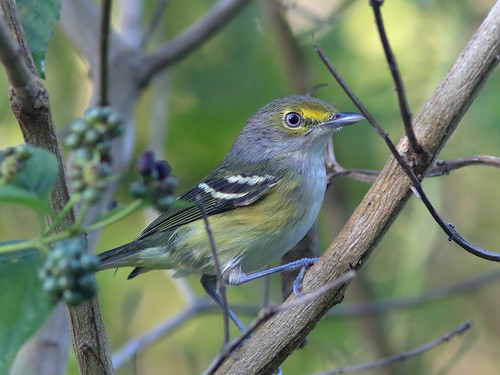
It suddenly detected my presence. One look and it fled:

A vigilant Northern Mockingbird kept me in sight:
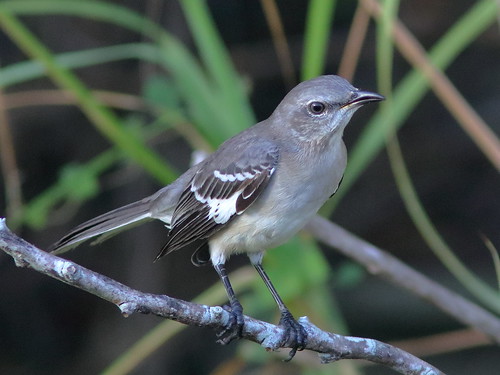
Monarch butterflies are attracted to Lantana blossoms:
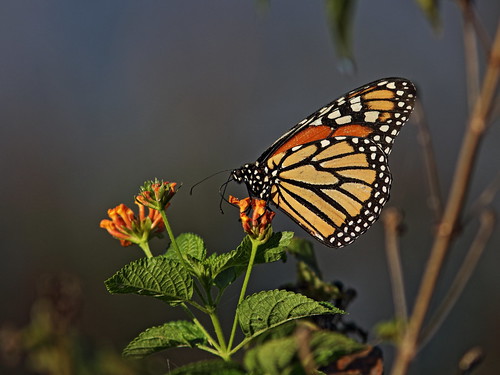
On October 25 the Hunter's Moon was setting across the lake as I was birding in that patch of Lantana...
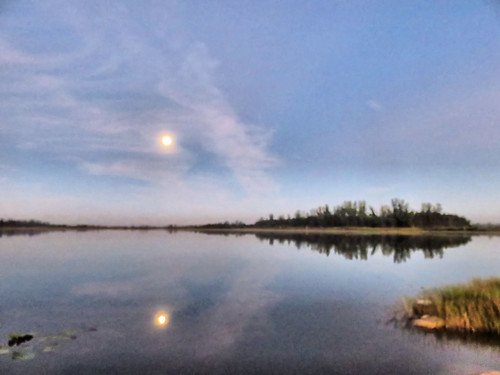
...and was amazed to find a Monarch butterfly wearing a numbered tag:
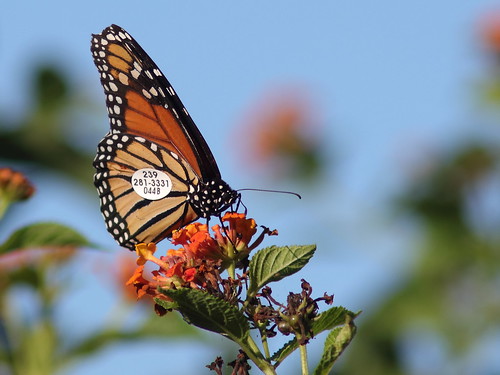
This led me to call the telephone number on the tag. The call opened a whole new world of knowledge about the ecology of this species. Of course I knew that Monarchs migrate south in the fall to gather in huge winter swarms and then progress northward in a multi-generational spring migration. I will not forget the cloud of these butterflies which, one autumn in the 1970s, surrounded the windows of my 17th floor office in downtown Dallas, Texas.
Texas serves as a geographic "funnel" which concentrates the southbound Monarchs on their way to overwinter in Mexico in huge aggregations. Some also stream down the east coast through Florida. Western populations may end their journey in California. What I learned when I placed that call to report the tagged butterfly was that the Monarchs of south Florida are non-migratory, and that well-intended human activity to help them may have adverse effects. The key is their dependence upon Milkweed.
Generally, the northbound Monarchs progressively follow the sprouting of Milkweed, and 3-5 successive generations may be produced during spring and summer. Their progeny fly to the northern US and southern Canada, compensating for the relatively short life span of the individual insects. Those which move into frigid climes may be doomed to freeze, but those who approach winter under milder conditions build up body fat, stop breeding, and turn around to migrate south nonstop to distant wintering grounds. In the meantime, the native Milkweed dies back, not to re-emerge until the next spring.
My photos of native Milkweed were taken in northeastern Illinois-- Monarch on common Milkweed (Asclepias syriaca):

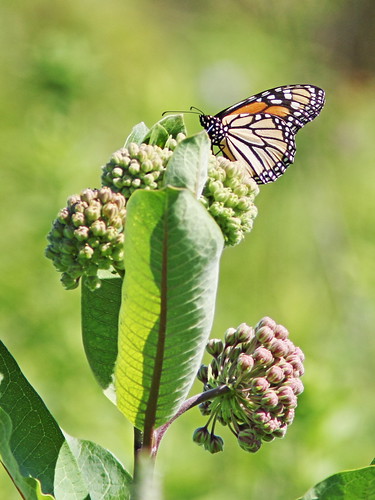
Milkweed patch:

Closeup of Common Milkweed flower:
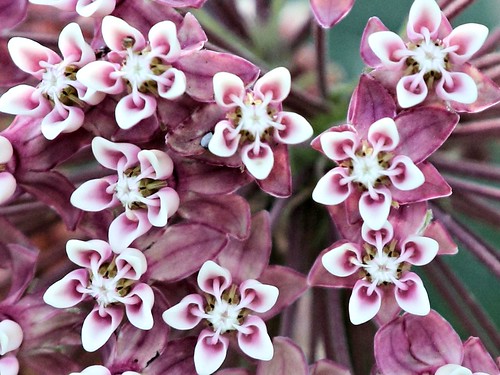
Green milkweed pods:
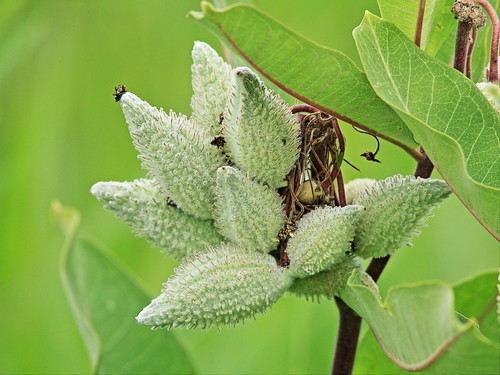
Dried up milkweed pods in late autumn:
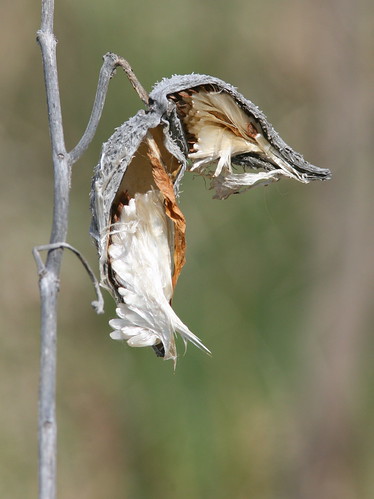
Butterfly Weed (Asclepias tuberosa) is a species of milkweed native to eastern North America:
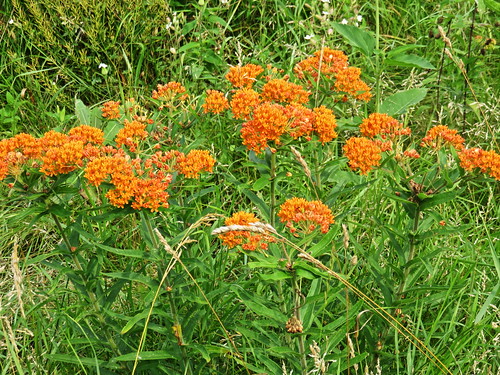
Since Monarchs depend upon Milkweed as a host plant for their eggs and caterpillars, their numbers are adversely affected by widespread conversion of land into cultivation and housing developments. Farmers certainly do not want this "weed" among their crops, and suburbanites do not regard them as attractive foundation plantings. Powerful herbicides target them.
Conservationists urge people to plant Milkweed for the Monarchs, and many people do this. So here's the paradox-- the easiest and most accessible nursery-grown Milkweed in southern US is non-native Tropical Milkweed (Asclepias curassavica). It blooms all year and is an attractive garden plant. Monarchs love it. However, it serves as the reservoir for a parasitic disease which is nearly confined to a single butterfly species (related Queen butterflies may also become infected to some extent).
Queen Butterfly on Shepherd's Needle (Bidens alba):
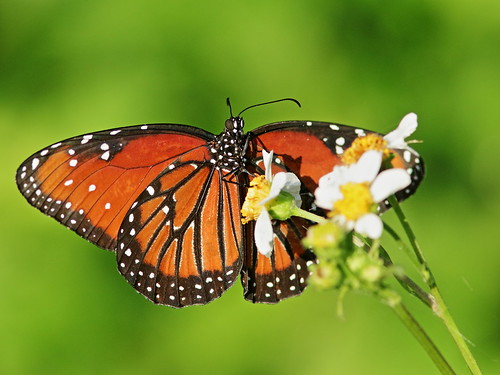
Ophryocystis elektroscirrha (OE for short) is an amoeba that invades the cells of Monarchs. They ingest their spores as larvae while feeding on Milkweed leaves. Tropical Milkweed is like a restaurant which never sweeps up its tables or launders the tablecloths.
Monarch caterpillars eat the OE spores which emerge through their skin after they undergo metamorphosis into adult butterflies. In turn, the adults visit to lay their eggs, each of which may be covered with many spores.The leaves, which are not renewed each season as are those of native Milkweed, concentrate the spores as multiple generations of Monarchs visit and reproduce on them.
OE has adverse effects on the health of some Monarchs, weakening them, causing wing deformities, smaller size and often premature death. There is some dispute as to whether the overall population benefits from the greater availability of Tropical Milkweed, thus outweighing the adverse health effects on some individual butterflies.
My tagged butterfly was one of the subjects of a study of the south Florida population which has lost the instinct to migrate, This probably evolved because Florida has native Milkweed species which are available all year round.
Researchers raise the caterpillars and sample the emergent adult Monarchs for the presence of OE spores before tagging and releasing them. Recaptured adults are also tested. A strip of sticky tape is touched to their bodies, providing an indicator of the presence and number of spores. Field reports, like mine, are compiled to gauge their longevity and wanderings.
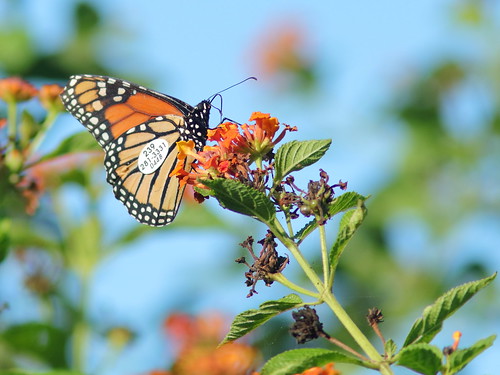
This week I received a call from the person who raised and released my tagged Monarch on October 12, thirteen days previously. She lives only about two miles east of our home. Interestingly, she raises her caterpillars on Tropical Milkweed and must bring the newly emerged ones inside to protect them from hungry exotic Curly-tailed Lizards until they build up enough toxin from the milkweed to make them repulsive to the reptiles.
Curly-tailed Lizard near our home:
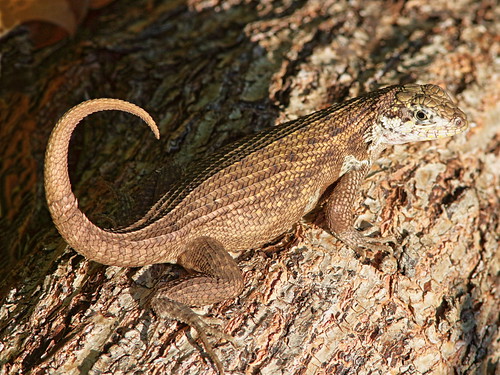
Tropical Milkweed (Asclepias curassavica):
Photo by Pablo Leautard protected by copyright under the FLICKR Creative Commons license. (You may share it for non-commercial educational or non-profit purposes with attribution to owner.)
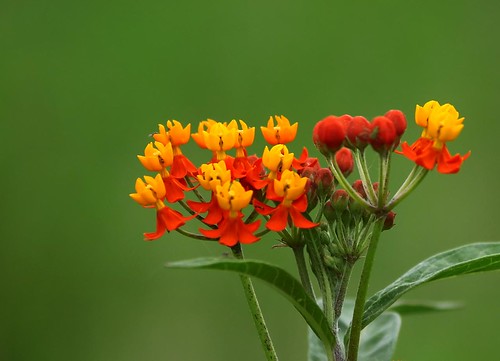
References:
Project Monarch Health is a citizen science project based at the University of Georgia in which volunteers from across North America sample wild monarch butterflies to help track the spread of the OE protozoan pathogen over space and time.
Plan to save monarch butterflies backfires- It started with the best of intentions. When evidence emerged that monarch butterflies were losing the milkweed they depend on due to the spread of herbicide-resistant crops in the United States, people across the country took action, planting milkweed in their own gardens. But a new paper shows that well-meaning gardeners might actually be endangering the butterflies’ iconic migration to Mexico.
What is OE (Ophryocystis elektroscirrha)? Why am I seeing adult monarchs with deformed wings?
Save our Monarchs -- Plant Native Milkweed
Fact Sheet about Tropical Milkweed and OE -- With a note about the non-migratory population in south Florida
= = = = = = = = = = = = = = =
Linking to Misty's CAMERA CRITTERS,
Linking to Eileen's SATURDAY'S CRITTERS,
Linking to SKYWATCH FRIDAY by Yogi, Sylvia and Sandy
Linking to WEEKEND REFLECTIONS by James
Linking to BirdD'Pot by Anni
Linking to Our World Tuesday by Lady Fi
Linking to Wild Bird Wednesday by Stewart
Linking to Wordless Wednesday (on Tuesday) by NC Sue
Linking to ALL SEASONS by Jesh
________________________________________________
Please visit the links to all these memes to see some excellent photos on display
________________________________________________
I'm off for some milkweed
ReplyDeleteA beautiful scene.
ReplyDeleteI didn't know they tagged the butterflies but love all the photos and info. Wish I could see a cloud of migrating monarchs.
ReplyDeleteVery interesting. I did not know this Milkweed flower at all...
ReplyDeleteI think we have some tropical milkweed around the house sprouting up from time to time. We also get monarchs. Fascinating to find one that's tagged and learn more about their natural history!
ReplyDeleteEnjoyed your story on the Monarch butterfly and its parasite...ain't Nature amazing?! What a blue sky!!! Polarizing filter on your lens?
ReplyDeleteAnother great series
ReplyDeleteGorgeous shots. I love colour so I especially love the red cardinal and the colourful flowers.
ReplyDeleteWell Kenneth, wheat a very written and informative post and I never knew that tagged these butterflies. Thank you for explaining about them so well with beautifully illustrated photographs. Have a lovely weekend.
ReplyDeletefascinating post. I have never ever seen a tagged butterfly, nor would I have thought they would be tagged.
ReplyDeletebeautiful photos...but scary about the Monarchs!
ReplyDeleteI am a fan of your photography.
ReplyDeleteWorth a Thousand Words
Hello, beautiful photos. I have never noticed a tag Monarch, great sighting. The White-eyed Vireo is a favorite, great sighting. The Monarch's can't seem to get a break. I know a lot of people have tried growing Milkweed for the Monarchs. I hope they do well. Thanks for linking up and sharing your post. Happy Saturday, enjoy your day and weekend! PS, thanks for the comment and visit.
ReplyDeleteI would not believe my eyes if I saw a number on the wing of a butterfly! How amazing and so great that you made the call and got the info. Very interesting...you never know what you'll see when you get outside! Love your birds pics this week too!
ReplyDeleteSo many amazing pictures. My favourites though are the White-eyed Vireo. So stunning.
ReplyDeleteInteresting post. Body fat? Hmm...
ReplyDeleteI've noticed milkweed patches are now encouraged to grow in some parks.
This was one of your BEST and very educational posts!! I didn't realize they tagged butterflies...interesting. And such gorgeous photos. Ps...photo 13 seems to have the shape of a bird on the left side of the seed pod.
ReplyDeleteThanks so much for linking in & sharing with us at I'd Rather B Birdin" this week.
What an interesting post! I tagged about 6 monarchs up here. When they fly south, of course, the milkweeds are done blooming. They feed on lots of other plants on their way to the sanctuary. I was so happy to see their numbers booming up here.
ReplyDelete(ツ) from Cottage Country Ontario , ON, Canada!
Oops, I guess you didn't want links. I just read that.
ReplyDeleteWe have had quite an uptake in Monarch numbers. I tagged 6 this year, well after the milkweeds stopped blooming. They feed on many plants.
@Jenn Jilks-- Hi, Jenn-- Your name as author of the reply contains a link to your Blogger profile which includes all your blogs and web pages. I thought my Blogger setting removed any links in the body of a reply as an anti-spam measure, but in fact I do have discretion to include your link, which I did.
ReplyDeleteThanks for your thoughtful remarks! Your Cottage Country looks beautiful, though a bit cold for my Florida warm blood!
I love Monarchs, they are so beautiful
ReplyDeleteFascinating! I wouldn't have thought it possible to tag a butterfly without making it impossible for him to fly.
ReplyDeleteThanks for sharing at http://image-in-ing.blogspot.com/2018/11/preparing-for-winter.html
Wow, there are fantastic captures... I enjoyed this post.
ReplyDeleteHello! Interesting post. Beautiful photos!
ReplyDeleteWed 2:30 I found the milkweed flowers on the linky list - many thanks for being a part of All Seasons - have a lovely rest of the week!
ReplyDeleteSuch gorgeous shots.
ReplyDeleteWow! What a lot of information from one phone call! Loving all your beautiful images of all types of creatures.
ReplyDelete